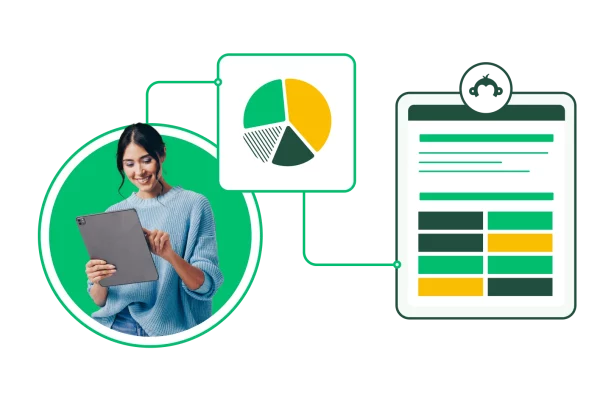Enhance your marketing with geographic segmentation insights

- Geographic segmentation is a type of market research. Marketers use geographic segmentation to group their target market by location.
- Marketers use geographic segmentation to increase the relevance of their campaigns, enhance competitive advantage, and optimize their marketing budget.
- A target market can be broken down by location, population density, time zone, and more.
Has your marketing strategy fallen flat? Maybe it doesn’t bring in the conversion rates that you expect despite your investment. Location may be a culprit.
A puffer jacket might not be a sought after item during Christmas in Australia when temperatures peak. Similarly, an egg-based product may not sell well in India, where many followers of Hinduism, the prominent religion, adhere to a lacto-vegetarian diet that excludes eggs. It’s all about location.
Geographical segmentation is a powerful tool for businesses to tailor their marketing efforts to specific locations. By understanding the unique characteristics of each area, companies can address local needs more effectively, improve the relevance of their campaigns, and increase conversion rates.
By leveraging geographic data, companies can create customized product offerings and marketing messages that align with local preferences, ultimately driving growth and customer loyalty.
What is geographical segmentation?
Geographical segmentation is a type of market segmentation that divides a target market into different geographical units, such as regions, cities, or neighborhoods.
Segmentation resolves the problem of broad, one-size-fits-all marketing strategies that often fail to resonate with diverse audiences. It enables businesses to focus their resources on high-potential areas, optimize their marketing spend, and stay competitive by quickly responding to regional trends and customer demands.
Demographic segmentation vs. geographic segmentation
What’s the difference between demographic segmentation and geographic segmentation? Both are types of segmentation used to group similar markets. But they have key differences.
Demographic segmentation focuses on characteristics like age, gender, income, education, and occupation. This segmentation helps target specific groups based on personal attributes. It is commonly used to tailor messages for different life stages or income brackets.
Geographic segmentation divides the market based on location. Marketers consider regional factors, like climate, population density, and cultural preferences. It is useful for addressing local needs and optimizing marketing efforts in specific areas.
To break it down, demographic segmentation targets personal characteristics, and geographic segmentation targets location. Demographics is about who the customer is; whereas, geography is about where the customer is.
You can combine demographic and geographic segmentation for a more precise and effective marketing strategy.
Geographic segmentation variables

Geographic segmentation variables are the specific criteria used to divide and analyze markets based on location-related factors.
Marketers use geographic segmentation variables to understand regional differences and tailor their approaches accordingly. Businesses also use segmentation variables to narrow and refine their campaigns, making their strategies more targeted and effective.
There are several key geographical segmentation variables:
- Location: Focuses on country, state, region, or city. Businesses can target areas where their products are in demand.
- Population density: Differentiates between urban, suburban, and rural areas. Marketing strategies can vary significantly based on population concentration.
- Climate: Considers weather patterns and seasonal changes. For example, products like winter clothing or air conditioners are marketed based on climate.
- Population growth: Targets areas with increasing or stable populations. Businesses can invest in growing markets to maximize returns.
- Economic conditions: Identifies regions with varying income levels. Tailoring products and pricing based on financial status ensures affordability and relevance.
- Time zones: Takes into account different time zones for marketing activities. This segmentation helps plan promotions and ensure customer support availability.
- Language: Recognizes regional languages and dialects. Adapting marketing materials to local languages enhances communication and engagement.
- Cultural preferences: Recognizes regional cultural differences. Tailoring marketing messages to fit local customs and traditions enhances relevance.
Why do marketers use geographic segmentation?
Geographic segmentation helps marketers tailor campaigns to specific regions. It allows businesses to address local needs, increasing relevance and effectiveness. This segmentation provides several benefits for marketers and consumers:
- Increased relevance: Tailoring messages to local preferences boosts customer engagement. Customers feel understood and valued. By understanding the unique characteristics of each region, businesses can create marketing messages that resonate with local audiences, resulting in higher engagement and better conversion rates.
- Improved customer satisfaction: Meeting regional needs increases customer loyalty. Satisfied customers are more likely to return and recommend the brand.
- Localized product offerings: Geographic segmentation allows companies to offer products and services specifically designed for local markets, improving customer satisfaction and loyalty.
- Optimized marketing spend: Businesses can allocate their budgets more effectively by focusing marketing efforts on locations with a high potential return on investment, reducing wasteful expenditure while increasing the return on investment for marketing campaigns.
- Enhanced competitive advantage: Companies that effectively use geographic segmentation can respond quicker to regional trends and customer demands, staying ahead of competitors who use a one-size-fits-all approach.
Geographic segmentation examples
The following geographic segmentation examples from SurveyMonkey customers show how businesses tailor their strategies to different audiences.
Beauty brand
Tech brands like Tweezerman use agile market research to tailor their strategies to different regions. Tweezerman uses SurveyMonkey to gather real-time consumer data from various global markets.
This market research helps them understand local preferences, validate product ideas, and adapt their offerings to meet regional demands, ensuring a consumer-centric approach that drives growth and engagement across diverse geographical segments.
Art supplier
Sakura of America uses geographic segmentation to tailor their product development and marketing strategies. By leveraging SurveyMonkey, Sakura gathers insights into regional preferences, allowing them to adapt products like gel pens to suit different markets.
For example, understanding that North American consumers may see pens primarily as writing tools rather than artistic instruments helps Sakura fine-tune its approach, ensuring relevance and success in diverse geographic segments.
Human rights group
Women's March Global (WMG) collects and analyzes worldwide data on women's issues. WMG uses SurveyMonkey Enterprise to gather real-time insights from various regions, allowing them to understand local needs and tailor their advocacy and support efforts.
This approach ensures that their initiatives address the specific challenges women face in different geographical areas, enhancing the effectiveness of their campaigns and resource allocation.
Grooming product manufacturer
Wahl Clipper uses geographic segmentation to understand and meet the needs of diverse markets. They gather insights from over 150 countries using SurveyMonkey, tailoring their products and marketing strategies to local preferences. For example, during the pandemic, Wahl Clipper identified a surge in self-grooming needs and adapted their offerings accordingly, ensuring they addressed regional differences effectively.
Auto Insurance provider
Elephant Insurance conducts weekly surveys using SurveyMonkey targeting specific designated marketing areas (DMAs). This geographical segmentation helps them understand regional awareness and perception, allowing them to tailor their campaigns to local demographics.
For example, Elephant Insurance uses insights from different DMAs to validate billboard and television ad campaigns, ensuring their marketing efforts resonate with targeted audiences.
Geographic segmentation benefits

Improved targeting and customization
Geographic segmentation allows marketers to create tailored campaigns for specific regions. For example, Tweezerman uses real-time consumer data to adapt its offerings to meet local preferences, ensuring its products resonate with different markets.
Enhanced customer satisfaction
By addressing regional needs and preferences, businesses can increase customer satisfaction. Sakura of America tailors its product development to suit North American consumers, leading to higher engagement and loyalty.
Better allocation of marketing resources
Geographic segmentation helps allocate resources more effectively. Companies can focus their marketing efforts on areas with the highest potential return, avoiding wasteful spending.
Increased market penetration and growth opportunities
Targeting specific regions can help businesses penetrate new markets and discover growth opportunities. Wahl Clipper identified a surge in self-grooming needs during the pandemic and adapted their offerings to capitalize on this trend.
Geographic segmentation disadvantages
Data collection and accuracy
Collecting accurate geographic data can be challenging. Differences in regional data sources and the cost of gathering comprehensive data can hinder effective segmentation.
Balancing customization with brand consistency
While customization is crucial, it can lead to inconsistencies in brand messaging. Maintaining a balance between local relevance and a consistent brand image is essential.
Adapting to changing geographic trends
Geographic trends can change rapidly, requiring businesses to stay agile. Women's March Global uses real-time data to adapt its advocacy efforts, but staying updated can be resource-intensive.
Managing logistics and supply chain is complex.
Targeting different regions involves complex logistics and supply chain management. Ensuring that products reach various markets efficiently requires careful planning and coordination.
Enhance your geographical segmentation strategy with SurveyMonkey
Embracing geographic segmentation allows marketers to allocate resources more efficiently, create relevant campaigns, improve customer satisfaction, and increase conversion rates.
Learn more about how SurveyMonkey can support your marketing strategy.
Discover more resources

Understand your target market to fuel explosive brand growth
Brand marketing managers can use this toolkit to understand your target audience, grow your brand, and prove ROI.

Hornblower enhances global customer experiences
Discover how Hornblower uses SurveyMonkey and powerful AI to make the most of NPS data, collect customer insights, and improve customer experiences.

Marketing trends: 3 strategies to stay relevant and ready for what's next
New SurveyMonkey research reveals critical insights on the state of marketing. Discover marketing trends to fuel your strategies and stay relevant.

8 marketing trends in 2025: consumer perspectives on AI and social media
Get insights on how AI and social media marketing activities impact consumer buying decisions in our new marketing trends report